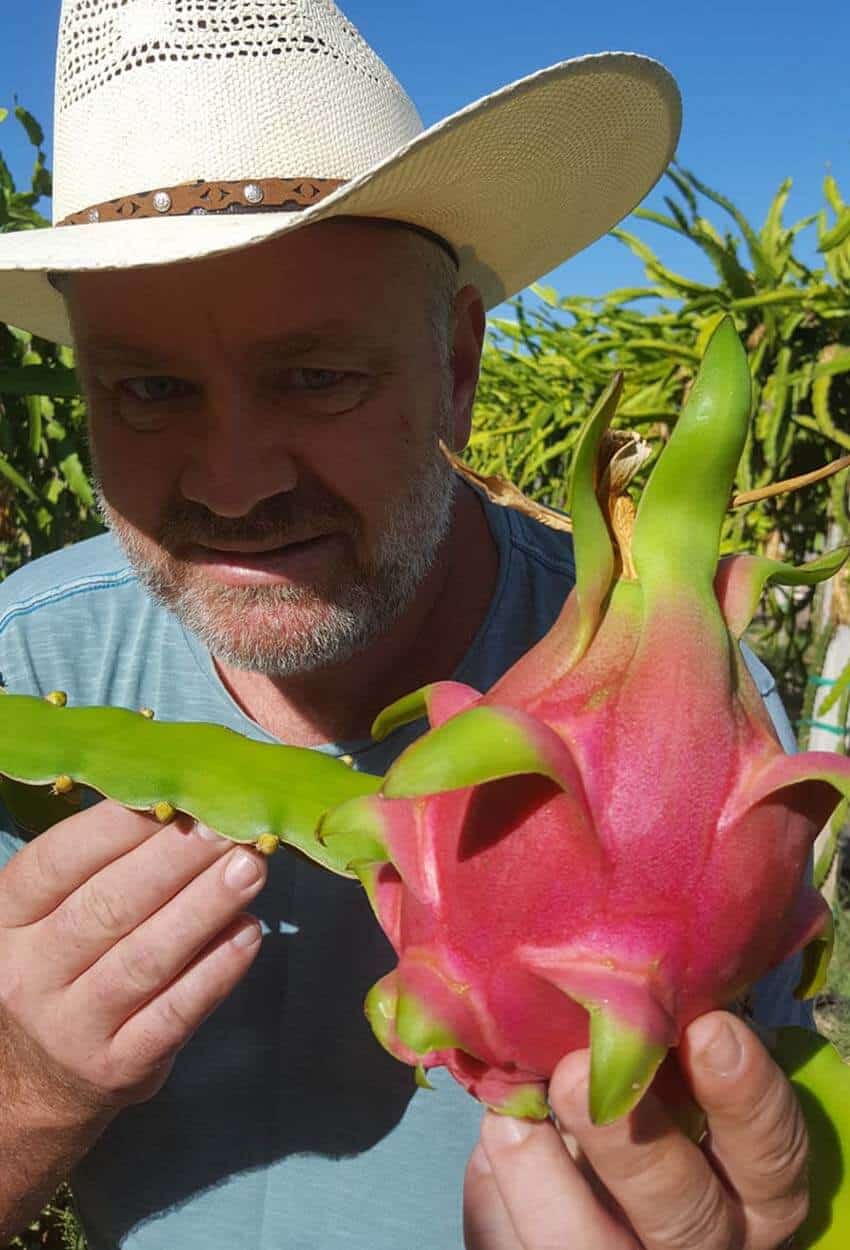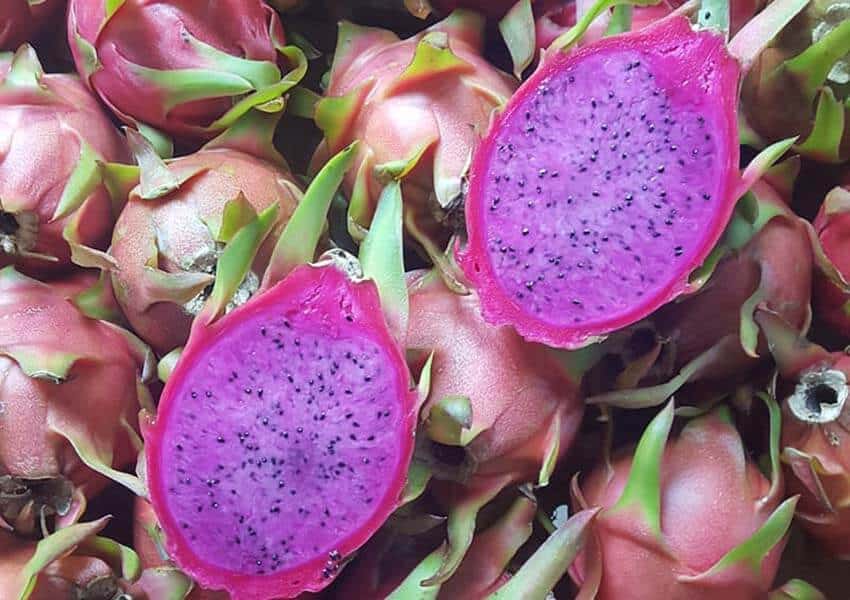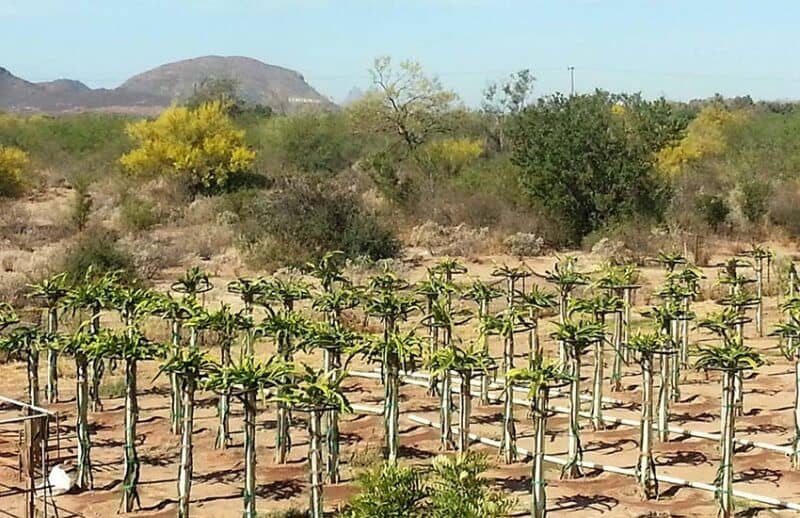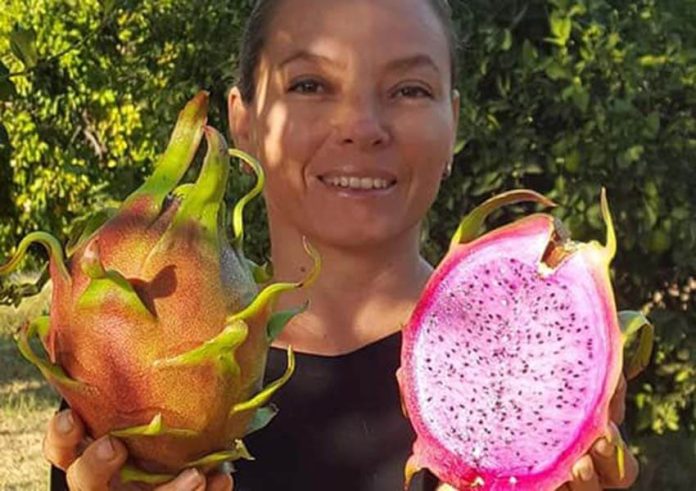Elizabeth and Greg Hovey let the world watch as they started a project that experts and even their families thought was crazy. Today, they are Sonora’s self-proclaimed “dragon fruit slayers,” growing the cactus fruit on a ranch outside San Carlos.
She is from Ciudad Obregón, Sonora, and he from Santa Barbara, California. After meeting online, Greg drove from Scottsdale, Arizona, to Hermosillo, Sonora, for their first date and, “… knew I wanted to marry her then.”
The couple worked in health insurance sales for over a decade. About 15 years ago, they became early digital nomads, working online and moving over 20 times to different places in the United States, Mexico and the Dominican Republic.
But in 2016, the couple decided they needed a change. They did not know what until they came across “these funky-looking fruits,” according to Greg.
“We had no idea what they were or how to eat them, but it gave us this idea that we should be farmers,” he says.

“Both of us are very impulsive,” Elizabeth admits.
They began researching, running the numbers to see if it was a viable business. With organic, high-quality fruit running up to US $15 a pound, that certainly seemed to be the case.
And so Rancho Pitahaya was born.
Dragon fruit — known as pitahaya in Spanish — grows in Latin America in southern Mexico and downward into South America, but “since [Elizabeth’s] family is nearby and we love San Carlos, we chose to grow it here” in the deserts of coastal Sonora, Greg says.
The couple was told by experts and scientists that the plant could not grow there, but they decided that with some adaptations they could find a spot that was not too dry, too hot or too cold.
Finding that right spot was a televised process. Their idea of growing dragon fruit got the attention of the HGTV channel’s show Mexico Life, and the episode aired in 2016. A follow-up aired in September 2020.
Dragon fruit may be expensive in the States, but it does not appeal to everyone. Like most cactus fruits, they are low in sugar, especially the common white-pulp variety. Growers in California have been experimenting with hybridization with pinks and reds, creating much sweeter fruits.
Using California cuttings and continuing the process of hybridization, the Hoveys have gotten fruit that measures up to 18–22 on the Brix scale — which is used to gauge the amount of sugar in foods — compared to the normal 7–8 for the white variety. But this process is slow. Dragon fruit plants take seven years to produce marketable fruit.
Rancho Pitahaya also insists on using organic and sustainable farming practices.
“We are really into health and fitness, and chemicals are just really bad,” Greg says. “The worst one that they are using is phosphates for weeds. It has been proven to cause cancer, and in many places, it is illegal to use.”
The use of chemicals, he says, is also affecting local bee populations, forcing the couple to buy and maintain beehives to pollinate their crops.
Besides, they say, fruit grown organically tastes significantly better than those from conventional farms.

Rancho Pitahaya began with about half a hectare of land for experimentation. These plants now produce, but the amount is only enough to sell locally.
However, they are the only growers in 800 miles and set the price for the region. When the fruit comes in season (which is now), they are selling for about US $6.50 per pound or 250 pesos per kilo.
The two prices exist because their market consists of two groups: the large number of Canadian and American snowbirds who come in the cooler months and the local year-round Mexican population.
The other two hectares were planted a little later and should begin producing next year. They already have an agreement with Whole Foods, whose buyer declared their product the best she’d ever tasted.
They have no plans to expand direct production beyond the three hectares they purchased in 2016. They have already started working with farmers, other businessmen and even the government, which is interested in the possibilities that dragon fruit offers Sonora and the rest of Mexico. They offer cuttings and the knowledge that they have gained over the years.
One major attraction is that dragon fruit requires only a tenth of the water that citrus does (widely grown in Sonora) and has a much higher profit margin.
The Hoveys’ initial goal was to make a go of it simply as dragon fruit farmers, but because of the pandemic, they have also branched out into the sales of organic food products online. This came about after their principal local outlet, the Rescate Market in San Carlos, was closed down by authorities. They had a choice to either go into lockdown or “go for it” and find a way to market their fruit as well as other local organically grown products.
The result is San Carlos Fruits and Veggies. Customers order by Thursday; the Hoveys drive out to various local farms they know and trust and bring the orders to the San Carlos marina on Saturday for pickup. Buyers don’t even have to get out of their cars.
The operation has offered all kinds of produce in season, along with mango salsas, cheeses and fresh-squeezed orange juice.
As far as farming goes, the Hoveys are interested only in growing dragon fruit despite having tried various other kinds of cactus fruit.
“Dragon fruit is the most expensive fruit; it is the healthiest fruit; it is the highest in antioxidants. It’s used to fight cancer, diabetes and heart conditions. We are in love with it,” Greg says, adding that Mexico has provided Rancho Pitahaya with everything it needs.
“We could have never done this in the United States,” he says. “The land would have cost us too much. The water would have cost too much. The labor would have cost too much. All the regulations …

“Down here, we were able to do all that ourselves. We are grateful to have the freedom to do what we want to do.”
• Rancho Pitahaya offers tours of the farm and the local environment, as well as seven-course meals and “dragonritas.” Besides their Facebook page, you can reach them via WhatsApp at 622 138 8495.
Leigh Thelmadatter arrived in Mexico 18 years ago and fell in love with the land and the culture in particular its handcrafts and art. She is the author of Mexican Cartonería: Paper, Paste and Fiesta (Schiffer 2019). Her culture column appears regularly on Mexico News Daily.
